Ilkeston Town Walk - Stage 31 - Bottom
Of Town
w/e 20 February 2005
All this week's
pictures were taken with a Kodak DX6490

It has often been said that the English and the Americans are
two peoples separated by a common language. In America for example
"uptown" means "a residential part of town away
from the central commercial district" whilst "downtown"
is "the business centre of a city or town". In England,
or perhaps I should say in Ilkeston, "up town" means
the area in the centre around the Market Place; "down town"
refers to the middle part of Bath Street whilst the area at the
lower end of Bath Street that we are going to look at in this
stage of the Town Walk bears the somewhat disparaging monicker
of the "bottom of town".
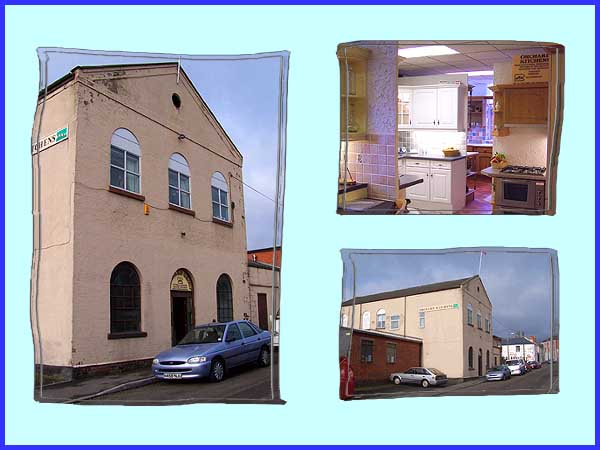
To reach Bath Street from where we left the last stage, we must
first turn off Rutland Street into Lower Granby Street where
on the left hand side we see a building now occupied by a local
business, Orchard Kitchens. The upper floor has been converted
into a large factory showroom with many kitchens on display but
over a hundred years ago the building was home to a temperance
church.  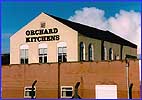 After being purchased by Leonard
Rogers and the proprietors of the New Theatre Royal on Lord Haddon
Road in 1909, it became the Hippodrome offering a mixture of
variety acts and silent films twice nightly. The small picture
on the right has been scanned from a photo loaned to me by Paul
of Orchard Kitchens and shows the building from the rear before
this view was obstructed by the erection of a new building. In
the days of the Hippodrome, there were entrances at both ends
of the building. After being purchased by Leonard
Rogers and the proprietors of the New Theatre Royal on Lord Haddon
Road in 1909, it became the Hippodrome offering a mixture of
variety acts and silent films twice nightly. The small picture
on the right has been scanned from a photo loaned to me by Paul
of Orchard Kitchens and shows the building from the rear before
this view was obstructed by the erection of a new building. In
the days of the Hippodrome, there were entrances at both ends
of the building.
|
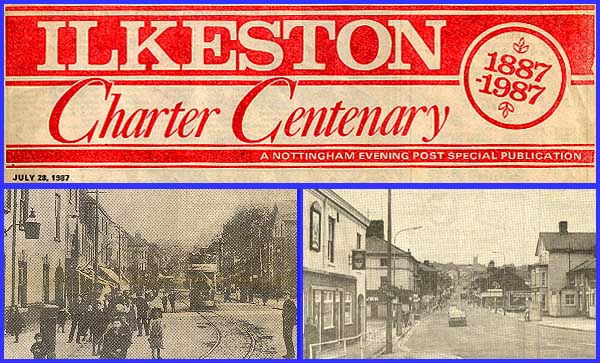
Continuing along Lower Granby Street and turning left into Granby
Street we can now approach what was, before the road alterations
and the construction of Châlons Way, the junction with
Bath Street and Heanor Road. Under the heading "Bath Street
then and now" a Nottingham Evening Post special publication
to mark the centenary of when Ilkeston received its Borough status
in 1887, featured on its front-page two photos taken, many years
apart, from approximately the same position.
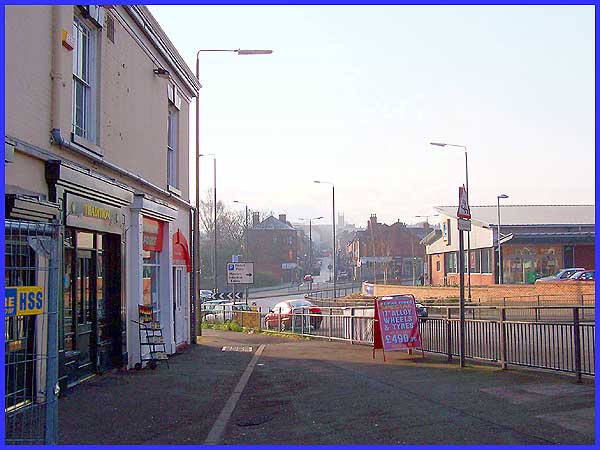
This 2005 image also from that position illustrates just how
much the area has changed since 1987. The most noticeable building
to have disappeared is the Rutland Hotel on the right.
|
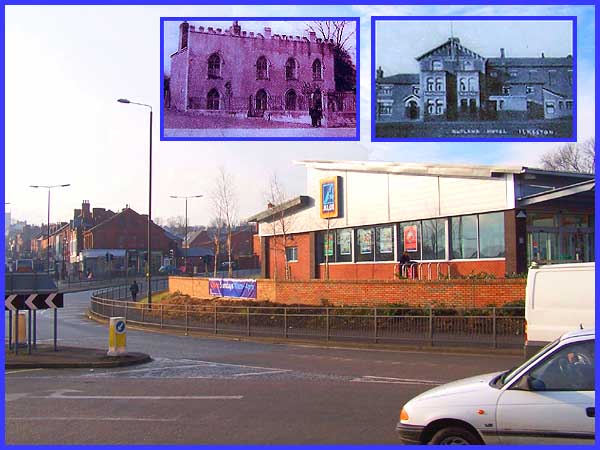
For a while in recent years the hotel became Kristies Night Club
but it has now been demolished and replaced by a cut-price supermarket.
The Rutland Hotel was built about 1820 as a stagecoach inn on
the Nottingham to Sheffield route and thrived with the arrival
of the railways in the 1840s. Adjacent to the hotel, Thomas Potter
built the Spa Baths about 1830 where people were able to take
the waters, both internally and externally, until the end of
the century when the baths were demolished. The waters were reputed
to be "the most powerful yet to be discovered in the kingdom"
and even in those days, the advertising men were not slow to
come up with a slogan - "If you're doubled with pain and
thin as a lath, Come at once, then, and try the famed Ilkeston
Bath." Although all signs of the baths have gone, the legacy
that remains is in the name of the street as it was previously
called Town Street.
|
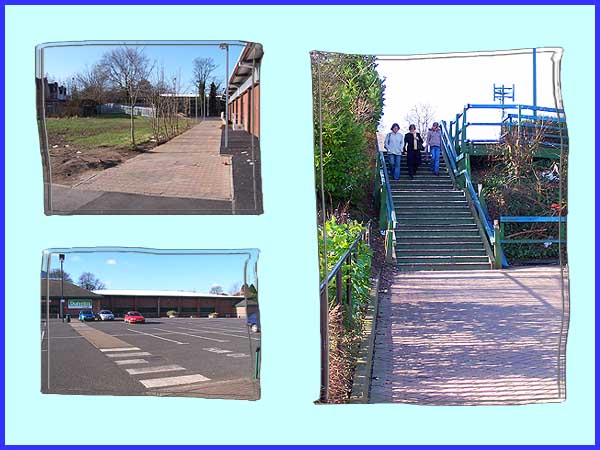
Prior to 1850, at the rear of the Rutland Hotel and Spa Baths
were the Vauxhall Gardens that were named after the famous London
pleasure gardens. Here Ilkeston residents and visitors could
enjoy quadrille bands, hot air balloon ascents and firework displays.
Later on the site of the gardens on land belonging to the Manor
House, a football ground was built and was home to Ilkeston United
- later to become Ilkeston Town F.C. There were several accesses
to the ground, one being via a path from Bath St which now looks
like the image top left. Steps that once led to the entrance
gate are now used mainly by shoppers. The football club played
their home matches on Manor Ground for well over a hundred years
until March 1992 when they moved to the New Manor Ground on Awsworth
Road (see Stage
29). Since then the ground has been redeveloped (bottom left)
into a retail outlet that has housed at least three different
companies in the intervening years.
|
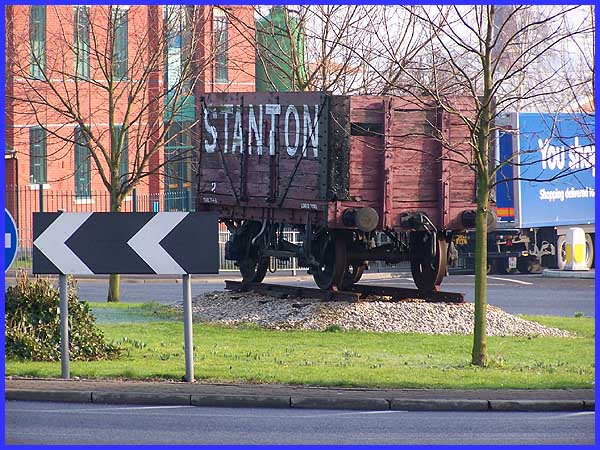
But now we must make our way to the bottom of the foreshortened
Bath Street and as we cross Manners Road we are treated to a
good view of the coal wagon that sits on the traffic island at
the end of Châlons Way. This serves as a reminder of two
of the area's major industries - coal mining and ironmaking.
The wagon, restored in Stanton Ironworks livery by volunteers,
was donated by the Midland Railway Centre at Butterley. It is
also situated close to the site of the old Town Station which
can be seen below.

The station was at the end of a branch line from Ilkeston Junction
opened in 1847 by the Midland Railway. For thirteen years carriages
were horsedrawn along the line and returned by gravity but the
station closed in 1870. Nine years passed before the station
re-opened to steam engines in competition with the rival Great
Northern Railway and their station on Heanor Road. It remained
open this time until 1959 but it had closed to passengers during
1947. No railway stations remain in the immediate vicinity of
Ilkeston but there are moves afoot for one to be opened a few
years from now.
|
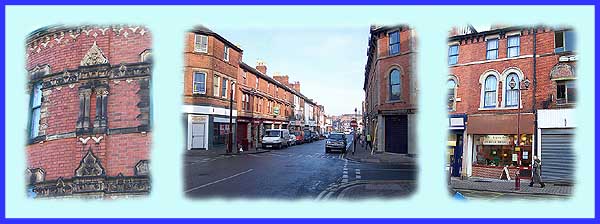
Now we return to Bath Street and here at the bottom of the hill,
a combination of a shopping centre, large retail outlets, the
economic climate, road alterations, the pedestrianistaion scheme
and no doubt many other factors created a shopping backwater
and many small businesses were forced to close their doors. Funding
has been allocated to renovate the area and many of the buildings,
some of them ornately decorated (above left) have been refurbished
and small businesses are being encouraged to move back into vacant
shops. One such enterprise is "The Ilkeston Coffee Bean"
(above right) which will bring back memories to people of a certain
age who remember a coffee bar in the shop next door when rock'n'roll
was young.
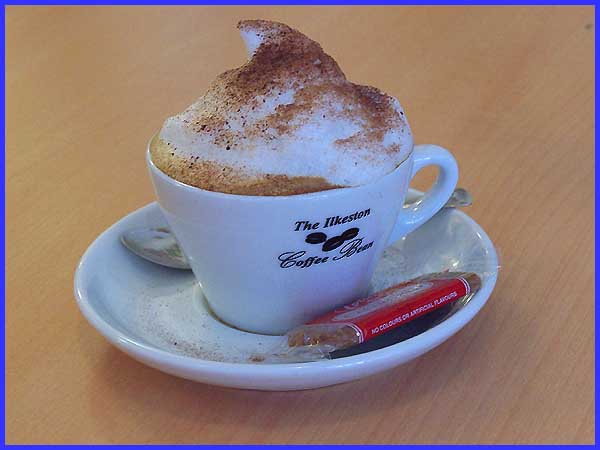
Despite its location at the bottom of the hill, or perhaps because
of, that coffee bar of the late 1950s was called the "Mountain
Top". In those days when juke box music and frothy coffee
were strictly for the young, the "Mountain Top" was
THE place to be seen. Now the juke box has gone but the cappuccino
coffee has survived and is enjoyed by all ages - and that includes
me. This one was delicious! Or as we said back then "Dig
this! It's real cool, Daddio."
|

